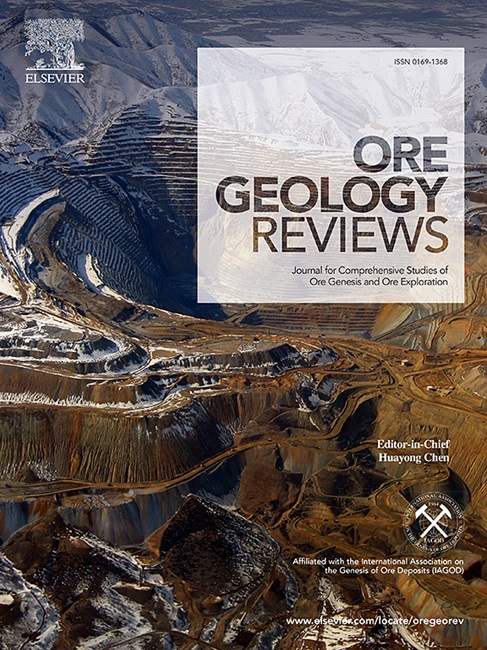深源变质流体在金富集中的作用——以藏南邦布金矿床为例
IF 3.6
2区 地球科学
Q1 GEOLOGY
引用次数: 0
摘要
准确识别成矿流体的演化过程和来源,是阐明大型金矿床成矿机制的基础,也是鉴别矿脉金矿床成因类型的关键。邦布金矿床(>40 t @ 7.0 g/t)位于藏南雅鲁藏布江成矿带东段,是青藏高原主碰撞阶段形成的重要金矿床。该矿床为研究挤压构造环境下大型矿脉金矿床的成因提供了极好的机会。矿体主要与断裂系统伴生,寄主岩为郎界雪群沉积变质岩。岩石学分析和横切关系确定了3个成矿阶段:(1)石英+粗粒黄铁矿,(2)石英+细粒黄铁矿+原生金+多金属硫化物,(3)无矿方解石。He和Ar同位素组成表明成矿流体为壳幔混合成因(3He/4He = 0.12-0.63 Ra;40Ar*/4He = 0.27 ~ 2.67),地幔贡献范围为1.65% ~ 10.93% (hemmantle)。氢氧同位素数据证实了成矿流体的深源变质成因,与提出的成因模式一致。黄铁矿的原位硫同位素组成(δ34SV-CDT = +1.82‰~ + 5.27‰)系统地记录了地幔储层的贡献。流体包裹体(FI)研究从这些阶段确定了石英中的四种FI类型:富液体(H2O)两相(l型)、富蒸汽(H2O)两相(v型)和含二氧化碳(液体和气体)包裹体(C1型和c2型)。进一步鉴定了4种流体包裹体组合(FIA),分别为A (L + V型)、B (L + c1型)、C (L + V + c1型)和D(仅为L型)。第一阶段的发展以四种不同类型的FIAs为特征,均质温度为234°C至334°C,盐度为2.40至6.29 wt% NaCl当量。这对应于中温、低盐度NaCl-H2O-CO2热液体系(mol% CO2 = 7.48 ~ 9.21)。相比之下,阶段II包括两种类型的FIAs (A和D),均质温度在198°C至282°C之间,盐度在0.53至5.85 wt% NaCl当量之间,表明NaCl - h2o占主导地位的热液系统。ⅰ、ⅱ期黄铁矿与原生金有关,分为Py1a、Py1b、Py2a、Py2b 4代。Py1a和Py2a的多孔/筛状结构表明Au的再活化主要由溶解-再沉淀(CDR)耦合控制。黄铁矿中As浓度升高(高达1.81 wt%),与Au呈正相关,进一步证明cdr驱动的深变质流体演化导致黄铁矿晶格畸变。这种变形似乎有利于金的掺入,从而增强其在矿物中的富集。因此,本研究认为,邦步金矿床是典型的造山带金矿床。本文章由计算机程序翻译,如有差异,请以英文原文为准。

The role of deep-sourced metamorphic fluids in Au enrichment: A case study of the Bangbu Au deposit, southern Tibet (Western China)
Accurately identifying the evolutionary process and source of ore-forming fluids is essential for elucidating the mineralization mechanisms of large-scale gold deposits and is pivotal in discerning the genetic types of lode gold deposits. The Bangbu gold deposit (>40 t @ 7.0 g/t), situated in southern Tibet within the eastern segment of the Yarlung Tsangpo metallogenic belt, represents a significant gold repository that originated from the main collision stage of the Tibetan Plateau. This deposit provides an excellent opportunity for examining the genesis of large lode gold deposits within a compressional tectonic environment. The orebodies are predominantly associated with faults systems, while the hosts rock comprise the sedimentary-metamorphic rock of the Langjiexue Group. Petrographic analysis and crosscutting relationships identify three ore-forming stages: (I) quartz + coarse-grained pyrite, (II) quartz + fine-grained pyrite + native gold + polymetallic sulfide, (III) ore-barren calcite. The He and Ar isotopic compositions indicates that the mineralization fluids are of a hybrid crust-mantle origin (3He/4He = 0.12–0.63 Ra; 40Ar*/4He = 0.27–2.67), with mantle contributions ranging from 1.65 % to 10.93 % (Hemantle). The hydrogen–oxygen isotope data corroborates the deep-derived metamorphic origin of the ore-forming fluids, aligning with the proposed genetic model. In-situ sulfur isotopic compositions of pyrite (δ34SV-CDT = +1.82 ‰ to + 5.27 ‰) systematically document mantle reservoir contributions.
Fluid inclusion (FI) studies identified four FI types in quartz from these stages: liquid (H2O)-rich two-phase (L-type), vapor (H2O)-rich two-phase (V-type), and CO2 (liquid and gas)-bearing inclusions (C1- and C2-types). Further identification of four types of fluid inclusion assemblages (FIA), designated as A (L + V-types), B (L + C1-types), C (L + V + C1-types), and D (only L-type). The development of stage I is characterized by four distinct types of FIAs, exhibiting homogenization temperatures from 234 °C to 334 °C and salinities ranging between 2.40 and 6.29 wt% NaCl equivalent. This corresponds to a medium-temperature, low-salinity NaCl–H2O–CO2 hydrothermal system (mol% CO2 = 7.48–9.21). In contrast, stage II encompasses two types of FIAs (A and D), with homogenization temperatures between 198 °C and 282 °C and salinities from 0.53 to 5.85 wt% NaCl equivalent, indicative of a NaCl–H2O-dominated hydrothermal system. Stages I and II pyrite related to native gold, and can be divided into four generations (Py1a, Py1b, Py2a, and Py2b). The porous/sieve-like textures of Py1a and Py2a indicate Au remobilization, predominantly governed by coupled dissolution-reprecipitation (CDR). Elevated As concentrations (up to 1.81 wt%) in pyrite, positively correlated with Au, further demonstrate that CDR-driven evolution of deep metamorphic fluids caused pyrite lattice distortion. This deformation appears to facilitate the incorporation of gold, thereby enhancing its enrichment within the mineral. Consequently, this study posits that the Bangbu gold deposit exemplifies a quintessential orogenic gold deposit.
求助全文
通过发布文献求助,成功后即可免费获取论文全文。
去求助
来源期刊

Ore Geology Reviews
地学-地质学
CiteScore
6.50
自引率
27.30%
发文量
546
审稿时长
22.9 weeks
期刊介绍:
Ore Geology Reviews aims to familiarize all earth scientists with recent advances in a number of interconnected disciplines related to the study of, and search for, ore deposits. The reviews range from brief to longer contributions, but the journal preferentially publishes manuscripts that fill the niche between the commonly shorter journal articles and the comprehensive book coverages, and thus has a special appeal to many authors and readers.
 求助内容:
求助内容: 应助结果提醒方式:
应助结果提醒方式:


